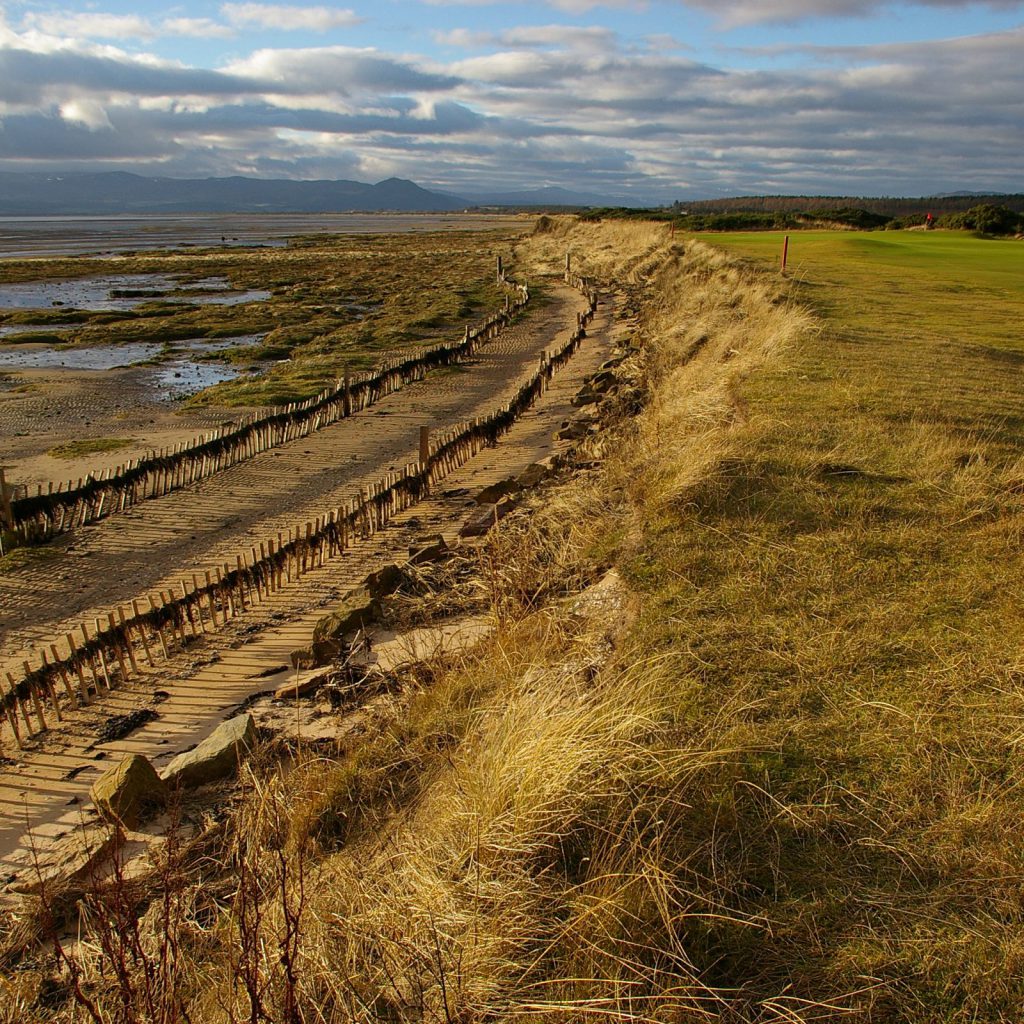Pioneering golf project to stop coastal erosion
Royal Dornoch Golf Club in Scotland is supporting a pioneering project that should help prevent part of its course succumbing to coastal erosion.
A report earlier this year warned that all of the links golf courses in the UK could disappear by 2100 due to climate change, and a number of gaps in the saltmarsh habitat in the Dornoch Firth means part of Royal Dornoch’s Struie Course is vulnerable to flooding and being lost to the power of the waves.
However, a new project will transplant hundreds of greenhouse-grown native saltmarsh plants to help restore the natural defences.
Saltmarshes provide important habitat for a wide range of wildlife and could protect coastal land from flooding and erosion. However, shoreline degradation and climate change are increasingly placing these grassland areas under threat.
Dr Clare Maynard, a research scientist at St Andrews University and chair of the Marine Alliance for Science and Technology (MASTS) Coastal Forum, is the project manager of Green Shores, a £155,000 scheme promoting the restoration of saltmarshes.
Royal Dornoch Golf Club is providing £10,000 a year for three years towards the project to help safeguard the 10th fairway on its Struie Course, which has been under attack from the sea.
Dr Maynard said: “Saltmarshes absorb wave energy. When we studied the Eden Estuary it was clear that land behind saltmarshes was in pretty good shape and far less likely to be eroded or flooded, whereas areas where there were no saltmarshes were clearly getting pounded by the waves and were at risk.”

She said gaps of tens of metres in the saltmarsh habitat close to the Struie Course are causing concern: “Coastal erosion is at its worst at the gap in the protective saltmarsh. There are flooding issues in the winter as well as year-round energy from waves degrading the edge of the course.
“There is a growing awareness in Scotland, and around the world, that saltmarshes and sand dunes play an important and underappreciated role in protecting our coastline. Projects like this, which work with nature to protect our important assets, will be critical in turning the tide on the increased erosion we expect with climate change. Our efforts here on the Dornoch Firth will help ensure the course remains playable for decades to come.”
She said a ‘spadeful’ of healthy saltmarsh plants will provide at least 100 transplants. These will be cultivated and then taken to the Dornoch Firth. Individual plugs, around 5cm in diameter, will be planted into the sand, supported by bio-rolls filled with coir, a natural and sustainable waste product from the husk of coconut shells, to act as wave breaks.
“The use of bio-rolls is an innovation of the Green Shores project. They have been used on shorelines with mixed success in the US and in the south of England, but only on riverbanks in Scotland. So, this is a first, and Royal Dornoch Golf Club is instrumental in pioneering the strategy in the eastern Highlands.”
The plants will spread out as they grow, filling in the gaps and joining the natural saltmarshes. The plants also trap sediments, raising the surface elevation, which allows the marsh to keep pace with sea level rise. The project will be repeated next year, using plants grown in the school greenhouse, and possibly 2020 if funding allows.
Dr Maynard added: “We will fill in the gaps with saltmarsh transplants to provide a soft engineering solution to this problem in a way that is good for everyone as it helps the environment and there is no need for an expensive sea wall.
“It’s a long-term process, not a quick fix, and while we cannot stop the sea, we can buy time for the golf course simply by having more naturally robust habitats in front of the course.
“Approaches like these, which work with nature, are being recognised as important complementary or alternative approaches to traditional engineering solutions. Given the increasing erosion we’ve seen on Scotland’s coast in recent decades, we need as many options as possible to ensure our highly valued coastal businesses are resilient to climate change.”
The club, along with Scottish Natural Heritage, the Scottish Environment Protection Agency, the St Andrews Links Trust, the Ministry of Defence, Fife Council, the Scottish Rural Development Programme’s LEADER, MASTS and local community volunteers also support the project.
Dornoch Academy pupils will help greenkeepers, researchers and community volunteers with the transplant effort and will grow saltmarsh plants in school greenhouses for planting next year.
Neil Hampton, Royal Dornoch’s general manager, said: “in 2010 we noticed a gap appearing in the saltmarsh affecting the 10th hole. If nothing was done we could have lost the whole fairway.
“We tried a number of methods to break the power of the waves, but when we learned of Dr Maynard’s work we decided it was the best way to tackle this potentially serious issue.
“It’s a natural solution and it involves the local schools and other local people, so it fits well with our commitment to the environment and the community.”
Dr Alistair Rennie, SNH Geodiversity Manager and Project Manager for Dynamic Coast, Scotland’s National Coastal Change Assessment, said: “Climate change is already affecting our shores. Scotland’s soft coast has seen an increase in the extent and rate of erosion since the 1970s.
“The Dynamic Coast project shows our natural defences protect £13 billon of coastal assets, more than twice the value protected by traditional coastal engineering. This is why working with nature is an essential approach to ensure our coastal communities, businesses, infrastructure and natural habitats remain resilient with climate change.”
Prof David Paterson, Executive Director of MASTS, added: “We are fully supportive of this environmentally-sound coastal habitat management and the work of Dr Maynard is a great example of new approaches supported by the MASTS Coastal Forum.”















Let me tell You a sad story ! There are no comments yet, but You can be first one to comment this article.
Write a comment